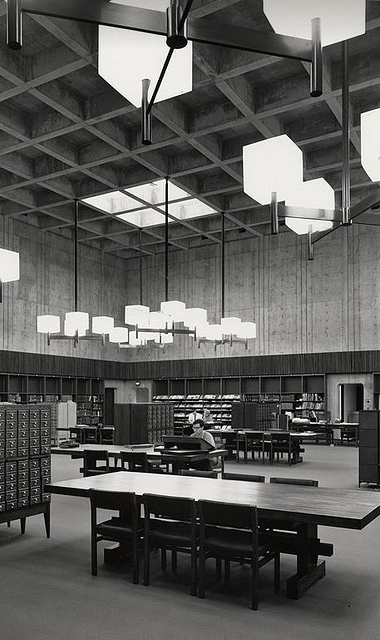 |
 |
 |
 |
|
Light streams down, clear and warm, through a glass grid in the ceiling, and as the day expands, shadow bands slowly find their way across the long wooden tables far below. The reading room is speckled with researchers of diverse ages, most of whom are tracing relatives long since returned to dust, and conversations rise and fall, ping-ponging back and forth, soft and reverbed and sounding like the origins of polyphony. Somehow, everyone in this book-lined corral seems further away than they actually are, until they're right beside you. Sitting here listening, the past is somehow more distant than ever and at the same time, closer to the skin. Camped beside a microphone, I zoom through the structure in my mind, through its fabric, into darkness, backstage, into the presence of the stacks behind. Free from my body and hovering among the index cards and packages and folders and the various collections of newsprint and magazines and celluloid and microfilm and magnetic tape and phone directories and muster rolls and prison records and on and on, through cages and fridges and racks and shelves and around endless corners, I sense their mass, the pressure of their desire to push back through the concrete and the rebar, back out into the sunlit present. A glimpse of a concrete slab flashing upwards. The steadicam descends to the basement, which is really a partially buried ground floor, and glides into the museum. History is here, Ohio from the perspective of glaciers and foxes and the Europeans who began to call themselves American, and those who were American before the designation existed. There are displays incorporating authentic signifiers which embody various key moments on the Ohioan time-line, artefacts like The Mica Hand, with its haunting looping musical accompaniment, and an electrically powered reproduction of a wooden mill, which groans and grinds ghost grain. Pushing out through the glass and I'm in the parking lot with the highway at my back, hovering at the foot of a sculpted staircase, a curve against the waist of this Brutalist hour-glass. As is often the case with these things, the building looks simultaneously precarious and impregnable, a massive top-heavy mega-fort sheltering the crest of an earth mound. The archives are up there, cantilevered out into thin air in a basement in the sky, wrapped around the reading room, encased in board-marked concrete and coated in a layer of bricks. And there they wait, safe for now, holding their breath in the darkness and the dust.
Mastered by David Donohoe. With thanks to Jennifer Lange and The Wexner Center for the Arts, Culture Ireland, The Arts Council of Ireland and the staff of the Ohio History Center. Special thanks to Diana Matuszak.
|
He also makes work which is exhibited in visual art contexts. He is represented by Green On Red, Dublin. |